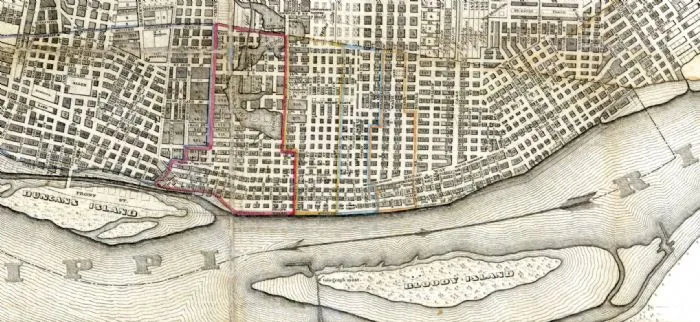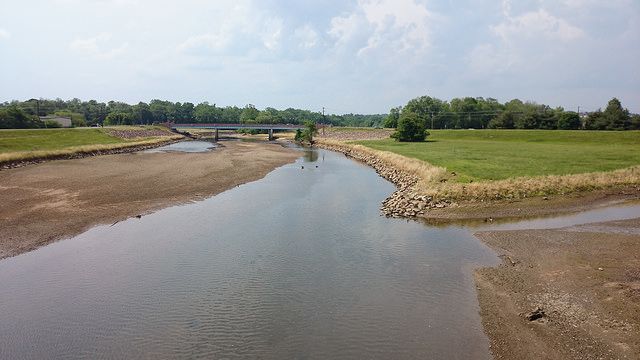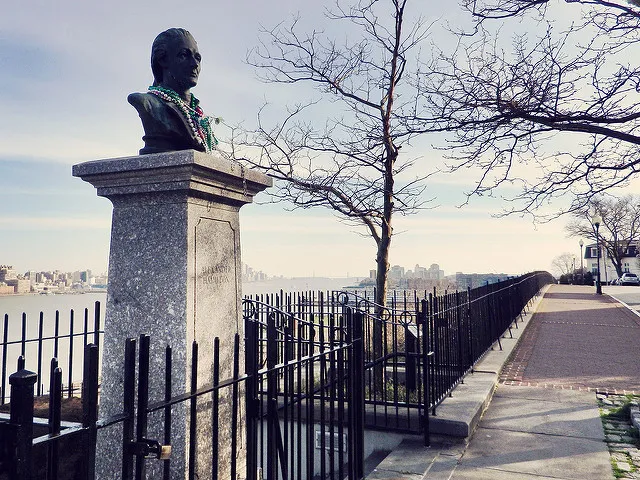Discover America’s Bloody History at Five Famous Dueling Grounds
Men defended their delicate honor at these bloody sites across the U.S.
:focal(511x443:512x444)/https://tf-cmsv2-smithsonianmag-media.s3.amazonaws.com/filer/48/b6/48b621be-16c7-420d-a95c-c5c8baa2dc43/cityparkneworleans2005-07oaktrees.jpg)
Alexander Hamilton’s last three words—“Pray for me,” according to some—could do nothing to save him from fast-approaching death, the result of a deadly duel between him and Vice President Aaron Burr in 1804. Over 200 years later, visitors might not realize that they can still visit the secluded New Jersey dueling ground where Hamilton and his son both died—and that the spot is just one of several infamous locations where America's early leading men met to defend their honor.
By the time Hamilton died in 1804, dueling had become a fixture in the United States. The bloody custom was brought over from Great Britain in 1621. The first two duelists were servants in Plymouth (which had only been founded the year before), Edward Doty and Edward Lester, who fought each other with swords. Neither died, though both suffered minor wounds.
Each duel had to follow the Code Duello, a set of rules governing the fights. A formal challenge noting the cause had to be issued; every duelist had a “second,” the person who handled logistics and tried to settle the duel without bloodshed; a meeting had to be arranged at a secluded place; the challenged chose the weapons, either matched pistols, swords or knives; a prominent community member served as a judge; and restrictions were necessary to reduce possible death. The goal of dueling was not necessarily death—according to the Code Duello, the duel was to end at first blood or nerve-rattling wound.
The reasons for dueling ranged from completely trivial to truly serious. “Public insults, romantic clashes, political disputes, cheating at cards… all could be cause for an encounter,” Eric S. Raymond, a swordsman and dueling expert, tells Smithsonian.com. “Classically one of the likeliest ways to end up in a duel was to ‘give the lie direct’; that is, publicly accuse another gentleman of lying.” Of course, the challenged did not need to accept the duel, but declining would peg them as a coward and harm their reputation.
Raymond says dueling faded out in the 1880s, and suggests that it ended because the intent was not always to outright kill someone. Early pistols were inaccurate and often misfired, but as weapons grew more sophisticated, he says, they also grew more deadly, leading to a sharp decline in the practice. Counterintuitive, he says, dueling was originally conceived of as a way to reduce overall violence in society—a practice aimed at reducing crimes of passion in favor of a more structured and regulated revenge process.
Some of the best remembered duels, however, are those that ended in tragedy. Here are five of the United States' most infamous dueling sites, all of which you can visit today:
Bloody Island; East St. Louis, Illinois

No longer a picturesque sandbar in the Mississippi River, this dueling spot is now a rail yard under the Poplar Street Bridge. Duelists flocked to the spot because it was considered neutral ground—not owned by either Illinois or neighboring Missouri, making it less likely that law enforcement from either state would stop the fight. Bloody Island saw its first duels in the early 1800s and the eventually became a hotspot for fights among society’s elite. Memorable duels include one between Thomas Benton and Charles Lucas, both prominent lawyers. Benton, no stranger to conflict, had previously shot Andrew Jackson in the arm in a street brawl. When Lucas insulted Benton's honor by challenging his right to vote, Benton called him out, and they dueled on Bloody Island. No one died—until Benton later accused Lucas of spreading rumors and challenged him to a second showdown. This time, Benton killed his rival with a shot through the heart. Benton went on to be elected to the U.S. Senate, becoming a close political ally of Jackson, who still carried Benton's bullet in his arm.
The Dueling Oaks; New Orleans, Louisiana
/https://tf-cmsv2-smithsonianmag-media.s3.amazonaws.com/filer/48/b6/48b621be-16c7-420d-a95c-c5c8baa2dc43/cityparkneworleans2005-07oaktrees.jpg)
Also known as City Park and Suicide Oak, New Orleans residents grew accustomed to watching the polite procession to a duel under the oaks almost every day in the 1800s. It was so popular that, according to the book History of Louisiana, more than ten duels were fought at the spot on one Sunday in 1839. Creole residents, who held their honor and their countryside in high regard, were the primary duel-fighters in the park; one duel in particular resulted when a European scientist insulted the Mississippi River.
Bladensburg Dueling Grounds; Colmar Manor, Maryland

This grove saw more than 50 duels starting in 1808. The land sits alongside a tributary of the Anacostia River called Dueling Creek and has also been called Blood Run and The Dark and Bloody Grounds. Each state had different laws about dueling and it was illegal here, so records of the fights are spotty—we may never know exactly how many men met their fate on this grass. The first fight here was between New York Representative Barent Gardenier and Tennessee Representative George Campbell, who charged Gardenier with insulting the United States by implying that the House of Representatives was too influenced by the French. Almost 30 years later, Francis Scott Key’s son Daniel was killed in a duel here over a disagreement about steamboat speed.
Weehawken Dueling Grounds; Weehawken, New Jersey

Hamilton and Burr met here on July 11, 1804, dueling over a rumor that Hamilton had been insulting Burr behind his back. The same guns were used from the duel that killed Hamilton’s son at the same spot in 1802. Burr’s fatal bullet stuck in Hamilton’s spine, where it stayed until he died the next day; accounts are mixed on whether Hamilton shot or not, and if he did, whether he deliberately or accidentally missed his target.
Kentucky Downs; Franklin, Kentucky
Once named the Dueling Grounds Race Course to honor its heritage, the track was renamed Kentucky Downs in 1998. The location was a popular spot for duels throughout the 19th century, with duelists heading over the state line from Tennessee, where the activity was illegal. Back then it was known as Lincompinch and was the site of two well-known duels. One, in 1827, pitted attorneys Calvin M. Smith and Robert M. Brank, who became heated during a trial concerning hog theft. Smith killed Brank, was brought to trial, charged with murder and eventually disbarred, which led to a Tennessee Supreme Court case that allowed attorneys to be stripped of their licenses for fighting duels.
Another took place between Tennessee Representative Samuel Houston and General William White, who brawled over Andrew Jackson's political appointments. Before the confrontation, Jackson reportedly advised Houston to bite on a bullet during the dueling to improve his aim. Although both survived, Houston's bullet struck White in the groin.
/https://tf-cmsv2-smithsonianmag-media.s3.amazonaws.com/accounts/headshot/JenniferBillock.png)
/https://tf-cmsv2-smithsonianmag-media.s3.amazonaws.com/accounts/headshot/JenniferBillock.png)